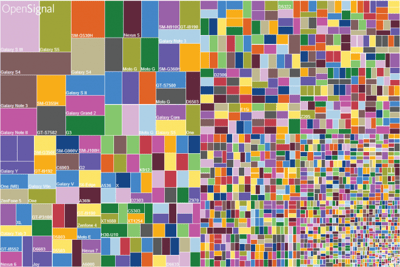
Blogs
Reverse logistics of smartphones – refurbished smartphone testing
Refurbished smartphone testing is not possible with traditional testing approach. Novel technology and thinking is needed in order to overcome the challenges. Especially you can see the problem, when you are trying to automate Android functional testing for refurbished phones.
There are 2.3B Android smartphones in use globally (*). And more and more smartphones are getting a second life as well. This means reselling the phone to another user when the primary user wants to get an upgrade. This reverse logistics business requires testing as well. If you want to sell it with a good price, the phone must work well.
The challenge of automatic testing in reverse logistics of smartphones is simply described with the image below (**Source: OpenSignal). The picture is commonly known by any Android app developer. It is a visualization of the different Android models in use. Admittedly, the picture itself is a little bit old (from 2014), but it shows the challenge. There are thousands of Android smartphone hardware variations that are in circulation. Only the left half of the picture contains more than 100 different models.
 When you then add the different Android OS versions to this, it’s a lot to handle. In order to test masses of smartphones in the reverse logistics business effectively, you need a lot of adaptation. The best part of human labor is good adaptation. That’s the reason why most reverse logistics and refurbishment companies are using manual labor in testing. A reverse logistics company may handle 1M+ devices annually.
When you then add the different Android OS versions to this, it’s a lot to handle. In order to test masses of smartphones in the reverse logistics business effectively, you need a lot of adaptation. The best part of human labor is good adaptation. That’s the reason why most reverse logistics and refurbishment companies are using manual labor in testing. A reverse logistics company may handle 1M+ devices annually.
Obviously, the variation they see is not as big as in this picture but it is still significant. By using a human workforce, the problem is accuracy, reliability and repeatability, as well as speed. Testing is a very boring job; the same things are repeated repeatedly, hundreds and hundreds of times in a day. This also results in a high turnover of the staff.
OptoFidelity approach – intelligent and adaptable test robotics
The best part of automatic testing is that it improves accuracy, reliability, repeatability and speed. And you will also get big data over time. But the nature of the Android market might cause some headaches to automated testing.
How to overcome the challenge of a fragmented Android market? You would want to use intelligent software and adaptable robotics. This means an approach where you do not need to change any hardware or anything else physically in a tester when changing the test batch to a different model, brand or OS version.
We at OptoFidelity have more than 15 years of experience in automatic, robot-aided testing. We call it test robotics. Over the years, we have developed intelligent software that controls the test robots. We call this the OptoFidelity ™Human simulator approach. Our Human simulator uses intelligent imaging software that can recognize the phone model, as well as adapt the testing robot automatically to the phone model requirements. The software can also record all data from the testing. When we combine the software with test robotics, we have something interesting: OptoFidelity´s test solution for automatic testing of Android smartphones, OptoFidelity ™ Fusion, comes with our testing APP, OptoFidelity ™ Pythia, which runs on the Android device itself. It will control all testing and communicate with the tester unit while running the tests.
You can upload any supported Android phone testing robot without any setup time or physical modification of the testing robot. And the placement of the DUT does not even have to be very accurate. Fusion will automatically detect the model and position of the device and adjust the robot with the help of its vision and intelligence.
Currently, we support almost 100 different Android smartphone models with our testers, with zero setup time, when changing the model or brand. And in case there is a new phone model which our tester does not recognize yet, it can be easily taught to the tester. The OptoFidelity ™ Pythia software includes a teaching tutorial for new phone models. After teaching, all the parameters of the new phone are stored in the database of the testers, and all stored phone models are available and automatically recognized by the test robot when a phone is placed into the tester.

OptoFidelity ™ Fusion test solution supports close to 100 different Android models. Supported phones include all major Android brands and even some operator-locked phones.
The adapterless testing solution, launched for the first time in Fusion, is also available for the testing of other smart devices from 2018, when OptoFidelity introduced a new testing solution, the OptoFidelity ™ Test Factory. OptoFidelity ™ Test Factory expands the range of the supported devices to literally all smart devices, including IOS devices, tablet-sized products with IOS or Android, smart watches or other smart industrial products.
What kind of data can I record with Fusion? you might ask. You can read some details from the Fusion solution page. Later on, we will also publish some sample data in our newsletter and website.
In case you are interested to read more about the solution, please follow the tags “smartphone”, “tablet” and “reverse logistics” on our website, or sign up to our newsletter. More information about OptoFidelity ™ Test Factory and OptoFidelity ™ Fusion behind the links.
OptoFidelity ™ Test Factory
references:
* https://newzoo.com/insights/articles/insights-into-the-2-3-billion-android-smartphones-in-use-around-the-world/
** https://opensignal.com/reports/2015/08/android-fragmentation/
www.opensignal.com
Written by


